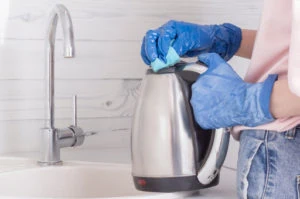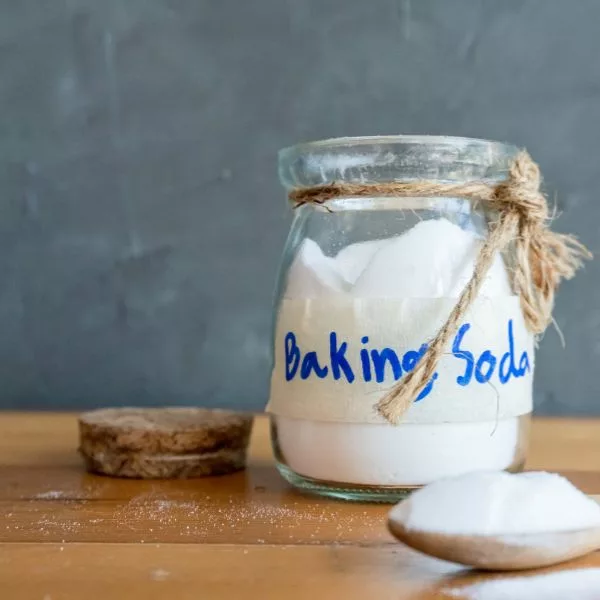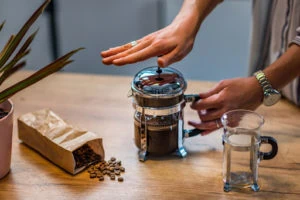When it comes to kitchenware that gets a lot of mileage, especially those frequently battling hard water and mineral deposits, stainless steel kettles are certainly at the top of the list. They help us brew the perfect cup of coffee, cocoa and tea with tea bags like green tea.
Over time you’ll notice a white buildup often a result of limescale buildup from hard water, affecting both electric tea kettles and stovetop kettles alike. If you’re really unlucky you’ll get rust too.

Today we’re going to share how to clean a stainless steel kettle & remove any rust so that you can get your beloved kettle back to its shiny stainless steel best. We’ll also cover preventative maintenance for your kettle, answer some popular questions, and even tell you how to shine up that exterior to a nice, mirror finish.
Let’s talk about what you need to know about cleaning your kettle the RIGHT way!
Wait, stainless steel rusts?
You betcha! While stainless steel is touted for its corrosion-resistant properties, it’s important to remember that it’s an alloy. At its most basic, stainless steel is iron and chromium, with a minimum of 10.5% chromium being required to call it ‘stainless steel’.
Other metals might come into play, with the most common being nickel (which makes the alloy more pliant to shaping), but the important consideration with our kettles is going to be that chromium content.
The chromium in your stainless steel is helping to create a layer to keep the iron from getting wet. Over time, water and minerals can build up, or abrasive scrubbings can eventually compromise that chromium layer and then you start getting rust.
Of course, nobody wants to be drinking rust, as that’s certainly not healthy (especially over time), but rust isn’t the only thing you’ll notice in your kettle when you’re cleaning it…
Limescale
That whitish buildup at the bottom of the kettle is called ‘limescale’, and it’s made up of minerals that get leached out of the water slowly over time and many boils. You’ll see that in your older kitchen pots, as well, and on household plumbing – especially old pipes and drains.
That limescale is harmless, but it can make your tea taste a little like you boiled pennies in it.
Now, the bad news is that once that chromium layer is compromised to the point that moisture is getting to the iron, there’s no way to ‘reseal’ it, but the good news is that it’s easy to clean and manage and if you’ve got a new kettle, you can help to avoid it for quite some time with a little ‘preventative maintenance’.
Let’s take a look, starting with those cleaning methods!
Cleaning methods
As the first step in your cleaning process, understanding the difference between cleaning an electric tea kettle and a stovetop kettle is crucial due to the presence of a heating element in electric models.
It never hurts to have more than one cleaning method at your disposal, so in the sections below we’ve provided some ways to clean your kettle properly and we’ll tell you a little about each. Done once every 1-3 months, you can ‘descale’ that limescale out of your kettle and get rid of that pesky rust.
Each method has its perks, so it’s just a matter of personal preference, as well as which of the household ingredients you have at hand. Let’s take a peek and you can see which methods you like the best!
Break out the big guns with White Vinegar
White vinegar is a pretty solid way to clean your kettle. Not only will you get the rust, but it helps to deal with limescale deposits quite nicely. You will need to do a little extra rinsing to get the vinegar out, but it’s also pretty potent due to the acetic acid in it that will be working its magic on that limescale.
What you’ll need:
- White vinegar
- Soft-bristled brush or a soft sponge
- a clean kitchen towel
Steps:
- Fill your kettle to the halfway point with vinegar and then top it off to the full point with water, creating a vinegar solution by mixing equal parts of vinegar and warm water.
- Bring your kettle to a boil and then turn it off and unplug it from the outlet.
- Let the kettle sit anywhere from 30 minutes to 1 hour, or if you have severe limescale, then you can let it sit overnight. The acetic acid in the vinegar should loosen the limescale up nicely.
- Once the time is up, break out your brush or sponge, and pour out the contents of your kettle so that you can clean up the loosened limescale. Note: ONLY use a soft bristled brush or a soft sponge – you want to avoid anything abrasive in your kettle, or you’ll just compromise that protective chromium layer further and you definitely don’t want that!
- For stubborn stains and thick paste-like mineral buildup, a repeat of the vinegar solution process may be necessary. If it’s clean then all you need to do now is give the kettle multiple rinses to get rid of the vinegar, dry out the inside with a clean kitchen towel, and you’re good to go!
Harness the power of citrus with a Lemon Juice soak
If the idea of rinsing out vinegar over and over doesn’t appeal to you, a lovely alternative you can go with is lemon juice.
While vinegar has acetic acid, lemon juice has the power of citric acid, and it’s pretty good at loosening up limescale and helping you get that rust out. It also smells quite nice, and that’s never a bad thing!
What you’ll need:
- 2 tbsp Lemon Juice
- Soft-bristled brush or a soft sponge
- a clean kitchen towel
Steps:
- Go ahead and fill your kettle up to the halfway point with water and add your 2 tablespoons of lemon juice.
- Bring the kettle to a boil and once it’s there, unplug it from the outlet and let it sit for an hour. If the limescale is pretty dense, then go ahead and let it soak overnight.
- Pour out your lemon water and you can give it a scrub with your soft-bristled brush or sponge. The limescale and rust may be a gooey consistency at this point and if it is, then just give it a good rinse.
- If all of the limescale is gone after the scrub and rinse, then simply rinse the kettle out a few more times until the citrus scent is gone and dry out the insides with your kitchen towel.
Get creative with the Cola Cleanse
Can’t stand the smell of boiling vinegar? If so, then you might like this little hack that became famous when a woman named Amanda Mendeville from Hampshire, England posted a video of herself trying it out in 2020 and it went viral. The hack involved pouring Coca Cola into her kettle and boiling it as a way to cleanse the limescale and rust.
Aside from arguably being the drink of choice around the world, Coke is used in all kinds of hacks, such as removing corrosion from battery terminals, oil stains in the garage, and even scrubbing the toilet, but how does it do with cleaning a kettle?
As it turns out, surprisingly well. We’ll list the steps below and you can give it a try yourself!
What you’ll need:
- Coca Cola (or another favorite soda)
- Soft-bristled brush or a soft sponge
- a clean kitchen towel
Steps:
- Fill your kettle up ¼ to ½ full of Coca Cola or another soda of your choice and bring it to a boil and then turn it off and unplug it.
- Let the boiled soda sit for 30 minutes in your kettle before pouring it out.
- Give it a good scrub with your soft-bristled brush or sponge and if there is any limescale or rust left, simply repeat the process as-needed.
- Rinse the kettle thoroughly to remove the soda smell, dry it out, and you’re done!
Bring on the Baking Soda

This natural product, when mixed into a thick paste, can address stubborn mineral buildup inside of the kettle.
Baking soda is famous for both cleaning and removing odors and as it turns out, you can certainly use it to clean out your kettle quite thoroughly.
Just follow the steps below and you can take advantage of its lovely cleaning properties!
What you’ll need:
- 1 tbsp baking soda
- Soft-bristled brush or a soft sponge
- A clean kitchen towel
Steps:
- Fill your kettle up to the halfway mark and NO MORE – baking soda will make the water bubble up as soon as you add it, and we don’t want you to be mad at us.
- Add your tablespoon of baking soda and once the bubbling stops, you can add more water until it’s up to the 2/3 mark.
- Bring your baking soda water to a boil and then unplug your kettle. Let it sit for one hour (or overnight if the residue is really bad).
- Pour out the baking soda water and give the insides a good scrub down with your soft-bristled brush or sponge.
- Rinse thoroughly a few times and dry out your kettle – Congratulations, you’re done!
Cleaning the outside of your kettle
Since you’ve gone to all of the trouble of cleaning the inside of your kettle, we thought we’d throw in a nifty and simple little way to bring that stainless steel to a lovely, lustrous shine!
To maintain the stainless steel surface and clean kettle exterior, a simple process involving a damp cloth and a small drop of olive oil can add shine to the outside of the kettle.
For tougher grease stains, a solution of warm water and a few drops of dishwashing liquid applied with a non-abrasive sponge can effectively clean the exterior of the kettle.
What you’ll need:
- 1 soft Microfiber cloth
- 1 tsp olive oil
- 1 small saucer
Steps:
- Put your teaspoon of olive oil onto a small saucer and dab your microfiber cloth into it lightly to get a small amount of oil. Start off small – with very little oil – and start shining your kettle.
- After a try or two you’ll find the perfect amount and just keep rubbing the kettle until it gets a mirror-shine!
Preventative maintenance is easy and saves you time later
Regular maintenance, including wiping the outside of a burnt tea kettle with a damp sponge and ensuring the inside of your tea kettle is free from calcium deposits, can significantly prolong the life of your new stainless steel kettle.
Use filtered water
For those concerned about the quality of the water and the taste of your hot beverage, using a water filter cartridge before filling your kettle can prevent mineral deposits in the first place.
Daily Quick-Clean
Cleaning your kettle at the end of the day can make an enormous difference and only takes a few minutes of your day. Mind you – this won’t completely halt the buildup of residue – but it will slow it down to a crawl and extend the life of your stainless-steel kettle.
What you’ll need:
- Mild dishwashing soap
- Soft sponge
- Hot water
- Small, clean kitchen towel
Steps:
- Dampen your sponge with a little hot water and add a drop or two of dishwashing liquid to it.
- Rubbing in small, gentle circles, clean the inside thoroughly with your soapy sponge.
- Give the kettle a thorough rinsing, drying it out with the kitchen towel once the soap smell is no longer present
Note: It’s important to make sure that you don’t leave water in the kettle. It’s a habit that will lead to limescale and rust at a much faster rate, so be sure to thoroughly dry it out once you’ve cleaned it.
FAQ
It’s just about time for us to call it a day, but before we go we thought we’d address some frequently asked questions that we get all of the time from our readers. Let’s take a look and then we’ll get to officially wrapping things up!
Why does stainless steel tea kettle rust?
There are a few different reasons why this might occur. For instance, the grade of stainless steel is an important factor. Higher-grade stainless costs a little more, but it’s a lot tougher and will last longer. Other factors include environmental ones, such as living by the seaside, but the most common reason that kettles rust is a simple one – lack of care.
Always dry out your kettle at the end of the day and give a quick clean with some dishwasher soap and water, drying it out with a clean dish towel when you’re done, and you’ll extend the life of your kettle substantially.
Is my kettle still safe to use with rust in it?
Small rust spots are not a problem, but if you see rust flakes then it’s probably best to remove the rust before you use your kettle. If the rust spots are very tony, then be sure to boil the water for 5 minutes and it should be fine.
Tiny amounts of rust will probably affect the taste of your beverage, but shouldn’t hurt you.
Does baking soda really remove rust from a stainless steel kettle?
Yes, baking soda can remove rust from stainless steel kettles and other stainless steel items in the house like your sink. To remove small rust spots with it, put 1 tablespoon of baking soda in a cup and slowly add water, mixing it with a spoon until it forms a paste.
You can apply this paste to small rust spots and then rub it gently with a soft cloth and this should remove the rust. After that, just give it a rinse, dry it, and you’re done!
Some Final Words
Today we’ve talked about how to clean a stainless steel kettle & remove any rust and as it turns out, you’ve got quite a few ways you can do it. White vinegar is a powerful method, but if you don’t like the smell, you could use lemon juice, cola, or baking soda to the same effect.
Just remember to dry the kettle out thoroughly and if you have the time, try to get into the habit of giving your kettle a quick clean and dry at the end of every day. It only takes minutes, but it can add years to the life of your favorite kitchen kettle.
Thanks so much for visiting us today and if you have a moment, please be sure to leave some tips of your own before you go – Nothing tops off an article better than a great discussion from our readers!
More kettle guide






